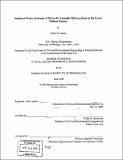| dc.contributor.advisor | Philip M. Gschwend. | en_US |
| dc.contributor.author | Adams, Rachel G. (Rachel Gwen), 1972- | en_US |
| dc.contributor.other | Massachusetts Institute of Technology. Dept. of Civil and Environmental Engineering. | en_US |
| dc.date.accessioned | 2005-06-02T15:29:36Z | |
| dc.date.available | 2005-06-02T15:29:36Z | |
| dc.date.copyright | 2000 | en_US |
| dc.date.issued | 2000 | en_US |
| dc.identifier.uri | http://hdl.handle.net/1721.1/17501 | |
| dc.description | Thesis (S.M.)--Massachusetts Institute of Technology, Dept. of Civil and Environmental Engineering, 2000. | en_US |
| dc.description | Includes bibliographical references. | en_US |
| dc.description.abstract | Polyethylene devices (PEDs), which rely on the partitioning of hydrophobic organic contaminants (HOCs) between water and polyethylene, were shown to be useful for the measurement of dissolved HOCs like polycyclic aromatic hydrocarbons (PAHs) in natural waters. These PEDs allow for the measurement of the fugacity or "fleeing tendency" of such chemicals in water. These dissolved concentrations are of ecotoxicological concern as they reflect the HOC fraction that is driving uptake by the surrounding organisms. Because PEDs require on the order of days to equilibrate in the field, their use provides time-averaged measurements. Laboratory-measured polyethylene-water partition coefficients for two PAHs were: 17,000 ±1000 (mol/LPE)/(mol/Lw) for phenanthrene and 89,000 ± 6000 (mol/LPE)/(mol/Lw) for pyrene. These organic polymer-water partition coefficients were found to be comparable to other organic solvent-water partitioning coefficients. These large coefficients allowed for the measurement of dissolved concentrations as low as 1 pg/L for benzo(a)pyrene and 400 pg/L for phenanthrene in the lower Hudson Estuary. Sampling performed in the lower Hudson Estuary during neap and spring tides revealed increased concentrations of dissolved pyrene and benzo(a)pyrene, but not phenanthrene, during increased sediment resuspension. These data suggest that resuspension events mostly influence the bed-to-water exchange of PAHs with greater hydrophobicities. PAH water concentrations predicted assuming dissolved and sorbed concentrations related via the product, fomKom, where fom is the fraction of organic matter in the suspended sediments and Kom is the organic-matter-normalized solid-water partition coefficient for the PAH of concern, were far from observed concentrations. Adding the influence of soot to the partition model via Kd = fomKom + fse,4Ke, where fse. is the weight fraction of soot carbon in the solid phase and Ke is the soot carbon-water partition coefficient estimated form activated carbon data, yielded predicted concentrations that were much closer to the observed values when PAH partitioning to soot was included in the partitioning model. This finding suggests that soot plays an important role in controlling the cycling of PAHs in the aquatic environment. However, even when the soot partitioning of PAHs was included in the model, the predicted dissolved values were still larger than the measured values. This suggests that the time of particle resuspension is too short to allow for particle-water sorptive equilibrium. Using ratios of source indicative PAHs, it was estimated that 90% of the dissolved PAH fraction was derived from petrogenic sources. In contrast, the same source ratios for the total (dissolved and sorbed) PAH concentrations indicated that only 55% of the total were petrogenically-derived. The observations in this work suggest that efforts to regulate and remediate PAH-contaminated sediments must consider the potential impacts of soot associations of the PAHs. | en_US |
| dc.description.statementofresponsibility | by Rachel G. Adams. | en_US |
| dc.format.extent | 112 leaves | en_US |
| dc.format.extent | 7765916 bytes | |
| dc.format.extent | 7765724 bytes | |
| dc.format.mimetype | application/pdf | |
| dc.format.mimetype | application/pdf | |
| dc.language.iso | eng | en_US |
| dc.publisher | Massachusetts Institute of Technology | en_US |
| dc.rights | M.I.T. theses are protected by copyright. They may be viewed from this source for any purpose, but reproduction or distribution in any format is prohibited without written permission. See provided URL for inquiries about permission. | en_US |
| dc.rights.uri | http://dspace.mit.edu/handle/1721.1/7582 | |
| dc.subject | Civil and Environmental Engineering. | en_US |
| dc.title | Sediment-water exchange of polycyclic aromatic hydrocarbons in the lower Hudson Estuary | en_US |
| dc.type | Thesis | en_US |
| dc.description.degree | S.M. | en_US |
| dc.contributor.department | Massachusetts Institute of Technology. Department of Civil and Environmental Engineering | |
| dc.identifier.oclc | 48258550 | en_US |
